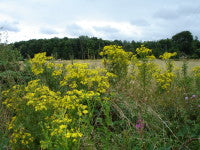Last chance to wipe out ragwort
 Ragwort is a resilient weed. A deep strong taproot and prolific seed production ensures continuity of weed plants at both stages of development (first year vegetative and second year flowering) for this biennial species into the following year. During August and September in particular you cannot miss the fact that you have a ragwort problem, and neither will anyone else. The toxic legally proscribed weed advertises its presence with swathes of golden yellow flowers on tall stems.
Ragwort is a resilient weed. A deep strong taproot and prolific seed production ensures continuity of weed plants at both stages of development (first year vegetative and second year flowering) for this biennial species into the following year. During August and September in particular you cannot miss the fact that you have a ragwort problem, and neither will anyone else. The toxic legally proscribed weed advertises its presence with swathes of golden yellow flowers on tall stems.
Attempts to scythe down ragwort may temporarily hide the problem but will only make matters worse in the long run because normally biennial plants will switch to a perennial lifestyle rather than dying after seed set which occurs in the normal course of events. Ragwort survives even a severe winter, courtesy its food rich tap roots, and resumes growth in spring to subsequently flower the following summer. What's more seeds already on scythed down ragwort stems will mature thus adding to the ragwort seed bank in the soil.
A group of pyrrolizidine alkaloids (predominantly 'jacobine') are responsible for ragwort poisoning in livestock, although their breakdown products called pyrroles actually cause the damage. Once eaten pyrrolizidine alkaloids are absorbed by the gastro-intestinal tract and then strike at the very 'heart' of metabolism by destroying liver enzymes to cause cirrhosis and death.
Horses and other equines are especially susceptible to ragwort poisoning.
The only way to control ragwort is the use of a recommended herbicide but spraying tall stems without contaminating agriculturally useful plants (pasture grasses and clovers) and ecologically significant species lower in the sward is practically impossible. Safe chemical control of ragwort is achieved using dedicated, direct-contact, non-drip application techniques collectively and colloquially called 'weed-wiping'. At the forefront is the Micron WeedSwiper a vehicle mounted applicator which cleverly exploits height differences in the sward, directly applying herbicide to tall ragwort stems without contamination of other plants by drips or drift.
 The Micron WeedSwiper is a direct-contact non-drip applicator that works off a 12 volt power supply and is available in various designs for tractor mounting or towing behind, for example, a quad bike or pick-up truck in addition to a tractor. WeedSwiper allows operators to deliver total non-selective (or selective) herbicides at minimal dosages (only that wiped directly onto the tall ragwort plants) without run-off onto shorter non-target plant species such as pasture grasses below.
The Micron WeedSwiper is a direct-contact non-drip applicator that works off a 12 volt power supply and is available in various designs for tractor mounting or towing behind, for example, a quad bike or pick-up truck in addition to a tractor. WeedSwiper allows operators to deliver total non-selective (or selective) herbicides at minimal dosages (only that wiped directly onto the tall ragwort plants) without run-off onto shorter non-target plant species such as pasture grasses below.
All units can be folded and operated at narrower widths than their designated maximum working width by utilizing the simple boom end break-back return system. For example the 3 metre unit allows application in 1, 2 or 3 metre widths.
WeedSwiper's Hydrostat electronic control system regulates the supply of herbicide wiped from the pads onto the ragwort foliage by switching the pump on and off in response to changes in the amount of herbicide in the pad material. The pad is continually saturated for maximum effective transfer of herbicide on to the ragwort plant, but never becomes over saturated to cause dripping irrespective of travel speed or weed density.
Sensors in the contact pads and the Hydrostat control system automatically control fluid flow to the pads which are made of a strong and tufted 'state of the art material' called RT with premium fluid retention properties. The 150 mm (6 inch) pads provide a three-dimensional reservoir of active ingredient and a large herbicide transfer area to ensure targeted ragwort weeds receive a sufficiently high dose of herbicide on contact with the pad. Pad height can be adjusted to suit a range of variables including terrain and height position of the ragwort infestation above valued plants in the sward below. All units are supplied with pad covers to prevent accidental contamination and to safeguard operator safety.
Further information and details from:
Micron Sprayers Limited, Bromyard Industrial Estate, Bromyard, Herefordshire, HR7 4HS. Tel: 01885 482397. Fax: 01885 483043 E-mail: micron@micron.co.uk Web: www.micron.co.uk
